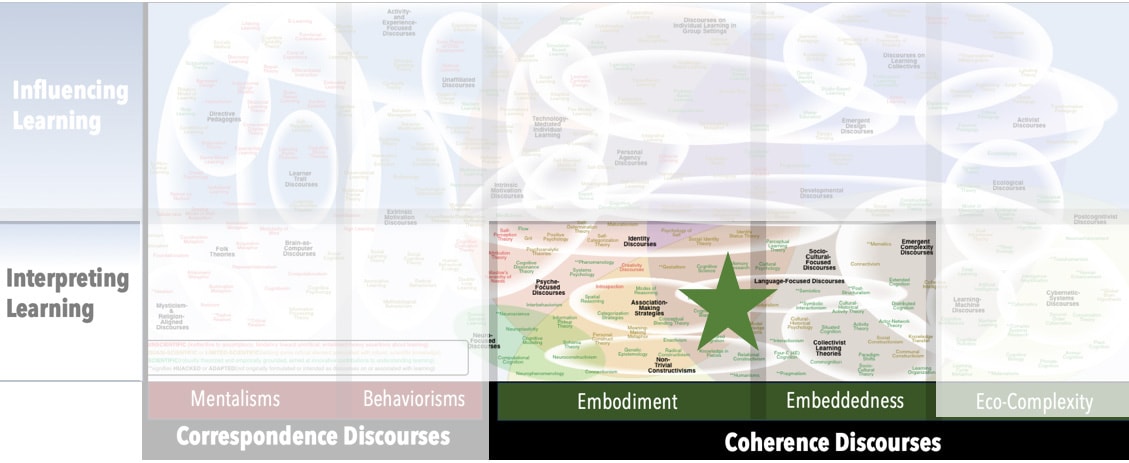AKA
Embodied Embedded Cognition
Embodied Mind
Motor Cognition
(not to be confused with Embodied Learning)
Focus
The bio-psycho-socio-cultural roots of meaningPrincipal Metaphors
- Knowledge is … scope of possible actions and interpretations
- Knowing is … appropriate functioning
- Learner is … a bodied agent (cultural situated)
- Learning is … selecting, blending, and refining possibilities
- Teaching is … designing experiences (orienting, juxtaposing)
Originated
1980sSynopsis
Embodied Cognition sits across Embodiment Discourses and Embeddedness Discourses in the assertion that humans are doubly embodied. That is, human cognition simultaneously depends on having a biological body and being part of a socio-cultural corpus. These two nested bodies are intimately intertwined: one’s physical body defines possible movements and ranges of perception; the grander context in which one is embedded defines appropriate actions and the scopes of interpretive possibilities. In this frame, then, one’s learning starts with ranges of bodily motions and perceptions. One’s context selects useful/appropriate actions and noticings, while offering means to extend and blend them into higher-order concepts (e.g., through strategies such as Conceptual Metaphor Theory and Conceptual Blending Theory). Most theories of Embodied Cognition embrace one or more of the following hypotheses:- Conceptualization Hypothesis (Lawrence Shapiro, 2010s) – the suggestion that one’s body defines (i.e., enables and constrains) possible thoughts/understandings. That is, organisms with very different types of bodies would likely interpret their “realities” very differently.
- Constitution Hypothesis (Lawrence Shapiro, 2010s) – the suggestion that the dynamic body and the responsive environment constitute cognition (vs. are factors in or components of cognition)
- Replacement Hypothesis (Lawrence Shapiro, 2010s) – an explicit rejection of most Mentalisms, along with their assumptions of internal representations and computational processes, in the suggestion that cognition can be defined in terms of the (inter)actions of an agent (with)in its environment
- Comprehensive Learning (Everyday Learning) (various, 2000s) – a term that is subject to many, often-conflicting interpretations, but that is increasingly used to signal the simultaneity of cognitive, affective, physical, and social dimensions of every moment of learning
- Bateson’s Levels of Learning:
- Zero Learning (Gregory Bateson, 1970s) – any change in how an agent responds to a specific circumstance that can be attributed to the simple receipt of information from an event that is external to the agent. Zero Learning refers to simple changes in behavior that cannot be assessed as “correct” or “incorrect.”
- Learning I (Proto-Learning) (Gregory Bateson, 1970s) – a change in how an agent responds to a specific circumstance that is associated with correcting an error
- Learning II (Deutero-Learning) (Gregory Bateson, 1940s) – a change in the learning process, typically associated with awareness of how and/or why one is learning. Examples include Learning to Learn (under Personal Agency Discourses) and Learning Transfer).
- Learning III (Gregory Bateson, 1970s) – a change in the system in which an agent is acting, in a manner that affords and compels new choices of action for the agent
- Learning IV (Gregory Bateson, 1970s) – a change in Learning III, which possibly can only occur in the combination of Ontogenesis and Phylogenesis (see Universal Darwinism). That is, Learning IV might happen only at the levels of interspecies evolution.
- Dual Coding Theory (Dual-Coding Theory; Dual-Code Theory) (Allan Paivio, 1970s) – a perspective aligned with Embodied Cognition that emphasizes a distinction between “nonverbal codes” (mental images in all their sensory forms) and “verbal codes” (human language in all its sensory forms). Unfortunately, despite an explicit rejection of Representationalism and Cognitivism, Dual Coding Theory retains much of the vocabulary of information processing, rendering the discourse easily misunderstood and readily misaligned with Brain-as-Computer Discourses.
- Grounded Cognition (Lawrence Barsalou, 2000s) – Often treated synonymously with Embodied Cognition, Grounded Cognition emphasizes the role of the body’s physical and social interactions in cognition.
- Haptic Cognition (Haptic Perception) – Derived from the Greek haptikos “able to come in contact with,” Haptic Cognition foregrounds the active body in learning. The term is employed in different ways, with meanings ranging from the opposite of Passive Learning (see Active Learning) to a synonym for Embodied Cognition.
- Perceptual Symbols Systems Model (Lawrence Barsalou, 1990s) – the perspective that one’s abstract understandings are tethered to bodily states, based on the frequent observation that recalling or thinking about a concept can reactivate sensations, motor actions, and other bodily states that were active when the concept was learned
Commentary
For the most part, criticisms of Embodied Cognition are rooted in diverse interpretations of the words “body” and “embodied,” both of which are encountered across the entire spectrum of theories of learning. Unless those words are understood in terms of nested, complex systems, Embodied Cognition is likely to be misunderstood. Concisely, criticisms of Embodied Cognition typically come from commentators who don’t understand the theory.Authors and/or Prominent Influences
Francisco Varela; Maurice Merleau-PontyStatus as a Theory of Learning
Embodied Cognition is a theory of learning.Status as a Theory of Teaching
Embodied Cognition is not a theory of teaching.Status as a Scientific Theory
Embodied Cognition is profoundly attentive to its grounding assumptions and supported by robust and diversified bodies of evidence.Subdiscourses:
- Comprehensive Learning (Everyday Learning)
- Conceptualization Hypothesis
- Constitution Hypothesis
- Dual Coding Theory (Dual-Coding Theory; Dual-Code Theory)
- Grounded Cognition
- Haptic Cognition (Haptic Perception)
- Learning I (Proto-Learning)
- Learning II (Deutero-Learning)
- Learning III
- Learning IV
- Perceptual Symbols Systems Model
- Replacement Hypothesis
- Zero Learning
Map Location

Please cite this article as:
Davis, B., & Francis, K. (2024). “Embodied Cognition” in Discourses on Learning in Education. https://learningdiscourses.com.
⇦ Back to Map
⇦ Back to List
